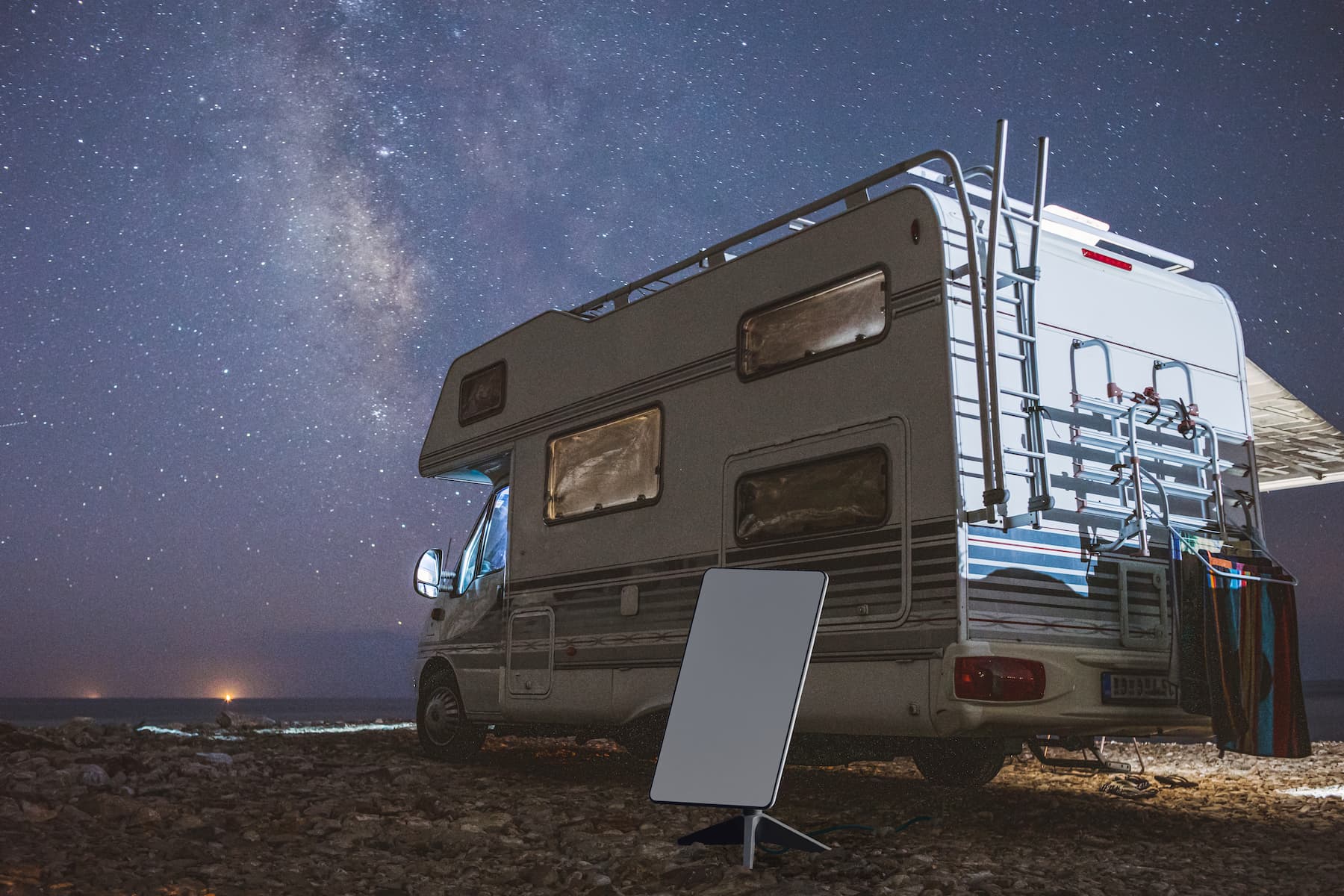Starlink Roam Unlimited Is Here, but Is It Worth It?
The latest iteration of Starlink’s portable internet is a bit of a mixed bag
Oct 29, 2024 | Share
News, Technology
Starlink customers now have the option to change their plan from the standard residential plan to the new Starlink Roam Unlimited, which allows customers to take their dish with them and connect to the internet anywhere they go. While this sounds like a great deal for the modest price increase, there are actually a few differences between the plans once you get into the fine print. Depending on how you use your Starlink connection, some of these technical details might even be deal breakers.
We’re going to walk you through these details so you can decide whether Starlink Roam Unlimited is right for you or not.
Find internet service near you
Are you looking for a more flexible internet plan? Enter your zip code below to see what options are available in your area.
What is Roam Unlimited?
Starlink has been working for a while on a portable satellite system. This program has gone through several iterations—Starlink Portable, Starlink RV, and now Roam Unlimited. Roam Unlimited replaces these previous plans, which are no longer available in the U.S.
Roam Unlimited can be used with the new Flat High Performance Starlink equipment, which, in conjunction with a Priority Mobile service plan, allows for in-motion use. This means that you can install your dish on your vehicle, and it will provide internet access within the vehicle while you are driving. (This feature is not yet available for Starlink Roam Global plans.)
You can also switch to Roam Unlimited while continuing to use your standard Starlink equipment. This will allow you to take your dish with you and get internet access at your new destination, but it won’t work while you are on the road.
Roam Unlimited also allows you to pause your service at any time, which means that you can get a Starlink Roam Unlimited plan to use when on vacation in the summer or fall and turn it off during the rest of the year when you don’t need it. Roam Unlimited is billed in flexible one-month increments, so with a bit of planning, you can pause your service in the months you won’t be needing it and reactivate it for the months when you’ll want to take your internet on the road

Roam Unlimited comes in two different plan options: a regional plan that costs $165 per month and a global plan that costs $200 per month. You can also upgrade your service plan to Priority Mobile for an additional $250. Standard Starlink equipment has a one-time cost of $599, while the new, Flat High Performance equipment costs $2,500. In-motion use requires both the Flat High Performance equipment and Priority Mobile service.
Starlink Roam Unlimited vs. Starlink Residential
In addition to portability and cost, there are some important technical differences between the different Starlink plans that impact their practicality.
| Plan | Cost* | Speed | Portability | Service Plan |
|---|---|---|---|---|
| Starlink Residential | $120.00/mo. | 20Mbps–150Mbps | Fixed Location | Standard |
| Starlink Roam Unlimited | $165.00/mo. | 30–100Mbps | Anywhere within your continent | Mobile |
| Starlink Roam Regional | $150.00/mo. | 5Mbps–50Mbps | Anywhere within your continent | Mobile |
| Starlink Roam Global | $200.00/mo. | 5Mbps–50Mbps | Anywhere in the world | Mobile |
| Starlink Mobile Priority — 50GB | $200.00/mo. | 40–220Mbps | Anywhere in the world | Priority Mobile |
| Starlink Mobile Priority — 1TB | $1,000.00/mo. | 40–220Mbps | Anywhere in the world | Priority Mobile |
| Starlink Mobile Priority — 5TB | $5,000.00/mo. | 40–220Mbps | Anywhere in the world | Priority Mobile |
Data as of 10/29/2024. Offers and availability may vary by location and are subject to change.
*Plus hardware, shipping & handling fees, and tax. Fully refundable. Depending on location, some orders may take 2 weeks or more to fulfill.
The big differences between the plans come down to cost, speed, portability, and service plan.
Cost
Starlink’s basic plan is pretty pricey, but are mostly on par with other satellite providers like Viasat and Hughesnet. The additional cost for Starlink Roam pushes those prices to some of the highest you’ll see with any residential internet plan. The Global version of the Starlink Roam plan will almost double your monthly internet bill. As such, you definitely want to make sure you’re going to get your money’s worth before switching over.
Speed
Although Starlink’s incredibly low latency is its biggest advantage over traditional geosynchronous satellites, its high download speeds were another big selling point early on. These optimistic estimates were scaled back as Starlink struggled to manage its growing network, with its current residential speeds falling between 20Mbps and 150Mbps.
Roam plans have slower speeds, topping out at a max speed of 50Mbps. This means that customers who upgrade to a Roam plan can expect speeds of around half of what they were getting before.
Portability
The big selling point of Starlink Roam is the ability to take your internet with you wherever you go. The Regional plan allows you to go anywhere on the same continent, which for U.S. customers, would allow you to take your dish to Canada, Mexico, and some Central American countries. The Global plan, on the other hand, should allow you to go anywhere in the world. There are, however, some restrictions.
If you spend more than two months in a foreign country, you must transfer your account to that country to maintain service. Also, many countries lack Starlink ground stations, which means that even though your dish can always find a Starlink satellite, those satellites might not be able to see a station to connect to the rest of the internet. Fortunately, Starlink’s new satellites all feature optical intersatellite links which can bounce your signal around until it can reach a ground station, but this means that your connection in these areas will be much slower and have much higher latency than normal.
Service plan
Just after the launch of its Roam plans, Starlink got rid of its data caps in favor of a three-tiered system of service plans. It has since simplified this system slightly by combining its plans and data together on its website, though it’s still not the most intuitive system.
Starlink Roam Regional and Global are now both options under the Standard Mobile service plan, which has the lowest priority on the network. When your connection is deprioritized, the network will deal with all other traffic first, then, if it has any additional bandwidth, it will try to get you the information you’re waiting for. This means that speeds can be slower than expected, especially during peak hours.
Deprioritizing traffic is exactly what happens with other satellite providers when you exceed your data cap for the month, so the current system of service plans is a roundabout way of implementing data caps without calling them data caps. Still, since the Mobile plan is technically a normal plan offering and not a throttling of your normal connection, you should still be getting speeds above Starlink’s advertised minimum speed, even if they are on the low end.
If you want the portability of Roam but don’t want to settle for low speeds, you can upgrade to the Priority Mobile service plan, which will move your connection from lowest priority to highest priority on the network. Mobile Priority has all the features of the Global plan, with the added benefit of in-motion use, priority support, and, of course, network priority.
Unlike the default Mobile plan, however, Priority Mobile data isn’t unlimited, and must be purchased in blocks of between 50 GB and 5 TB (5,000 GB). Priority Mobile customers can also opt-in to be charged by the gigabyte for any data used above their purchased allotment to ensure that they don’t lose their priority status. As mentioned, in addition to the Flat High Performance dish, Priority Mobile data is also required to use Roam’s in-motion feature.
Starlink has since added in-motion service below 10mph as a feature of the standard Mobile data plan, which is an odd choice. Since you can’t exactly strap a satellite dish to your bicycle nor idle your car all the way to work, my assumption is that this is simply a bug that they’ve chosen to call a feature. Much like trying to fool Pokémon go by driving really slowly, I suspect that Starlink has a hard time telling if you’re moving unless you’re going at least 10mph. Since they can’t fix the problem, they’ve decided to advertise it as a perk. Yay!
Starlink Roam Unlimited comes with some pretty nice features, but it also comes with a lot of drawbacks. Lower speeds, deprioritized connections, and supplementary data purchases can be deal breakers for professionals who use Starlink to work from home, though Roam’s flexible month-to-month payment plan can make it a viable (if somewhat expensive) secondary internet service for travel. Of course, the need for a separate, primary internet connection makes switching to Roam a risky choice.
How to switch to Roam (and also maybe don’t)
For current Starlink customers, switching to Starlink Roam Unlimited is incredibly easy and can be done from your Starlink account:
- Log into your Starlink account.
- Under Your Starlinks, find the plan you want to change and click Manage.
- Select the pencil icon next to Service Type.
- Change your subscription to Roam Unlimited and accept the new terms and conditions.
This will allow you to take your dish with you when you travel and set it up in a new location. This also changes your monthly bill and download speed to those of a Roam plan and removes the priority access you got with your residential plan. Changing your plan online will not give you access to in-motion use, as you will need to update your equipment to a Flat High Performance dish to make use of that feature.
One important detail to note is that while customers can switch from Residential to Roam, they cannot change back to Residential. If you’ve been using your standard Starlink plan or even a Starlink Portable plan to work from home and decide to try out Roam Unlimited, you’re stuck with slower speeds and Best Effort connections. If this doesn’t work for you, you can’t switch back. Your only option is to buy another Residential plan and dish like a new customer, which could take months to arrive.
We generally advise people who really want Roam Unlimited to buy it as a second plan, rather than switching their current plan over to Roam Unlimited. If you are thinking about switching over, make sure that you know exactly how much speed you need.
These more important internal links don’t stand out as much with all the external reference links we have to include now.
Ordering Roam Unlimited as a secondary connection
Although Starlink’s Roam Unlimited has a lot of deficiencies as a primary household internet connection, it has a lot of potential as a secondary connection for travel. Many people use mobile hotspots or portable 4G routers when traveling in order to ensure a reliable internet connection wherever they go. Roam Unlimited is a hotspot on steroids. Whereas most hotspots rely on 4G or 5G networks, which have limited coverage, Starlink’s low-Earth Orbit (LEO) satellite network gives you coverage even in the most remote locations.
Starlink Roam Unlimited vs other portable internet
| Plan | Cost | Speed | Connection | Get it |
|---|---|---|---|---|
| Starlink Roam Unlimited | $165.00/mo. | 30Mbps–100Mbps | LEO Satellite | View Plans |
| UbiFi | $129.99/mo.† | Location dependent | 4G LTE | View Plans |
| Ladybug Wireless | $124.99/mo. | Up to 60 Mbps | 4G LTE | View Plans |
Data as of 10/29/2024. Offers and availability may vary by location and are subject to change.
*Plus hardware, shipping & handling fees, and tax. Fully refundable. Depending on location, some orders may take 6 months or more to fulfill.
†30-Day Service Trial Included with purchase of Gateway.
Starlink Roam Unlimited’s monthly cost certainly puts it on the high end when compared to hotspots and portable 4G plans, though its speedy performance certainly justifies the cost.
The initial cost of the equipment, on the other hand, is a bit much for a secondary internet connection. At $599, the standard Starlink dish is almost twice the price of some of the most expensive mobile hotspots, and the $2,500 Flat High Performance equipment is a massive investment for most internet customers. Roam Unlimited is an undeniably cool bit of tech, but it definitely comes at a premium.
One advantage that Starlink Roam Unlimited has over many other mobile internet providers is its flexible billing system that allows you to pause service. When paused, you are not charged for service that month. Your Roam Unlimited service is charged in full-month increments and isn’t pro-rated, so you do have to plan ahead to make the most of your service. Still, this gives an incredible amount of flexibility to those who do a lot of traveling during certain times of the year.
The other big downside, of course, is Starlink’s struggling logistics. Standard Starlink equipment orders still have long wait times, whereas the new Flat High Performance equipment is currently available for order only in select areas. Again, these shipping delays aren’t so bad if you already have a primary internet connection for your household, but can be pretty difficult to deal with if it means going without internet for months on end.
The bottom line
Starlink Roam Unlimited is an impressive bit of technology, but its shortcomings make it hard to recommend over the standard Starlink Residential plan. It makes for a powerful secondary internet plan for travel, if the large upfront investment is worth it to you, but we don’t recommend it for your primary household internet plan.
Get Starlink Roam UnlimitedStarlink Roam Unlimited FAQ
Can Starlink Roam be used on a moving vehicle like an RV or a Truck?
Is Starlink Roam the same as Starlink Portable?
Where is Starlink Roam available?
Can I upgrade my current Starlink plan to a Roam plan?
How does pausing Starlink Roam work?
Author - Peter Christiansen
Peter Christiansen writes about telecom policy, communications infrastructure, satellite internet, and rural connectivity for HighSpeedInternet.com. Peter holds a PhD in communication from the University of Utah and has been working in tech for over 15 years as a computer programmer, game developer, filmmaker, and writer. His writing has been praised by outlets like Wired, Digital Humanities Now, and the New Statesman.




